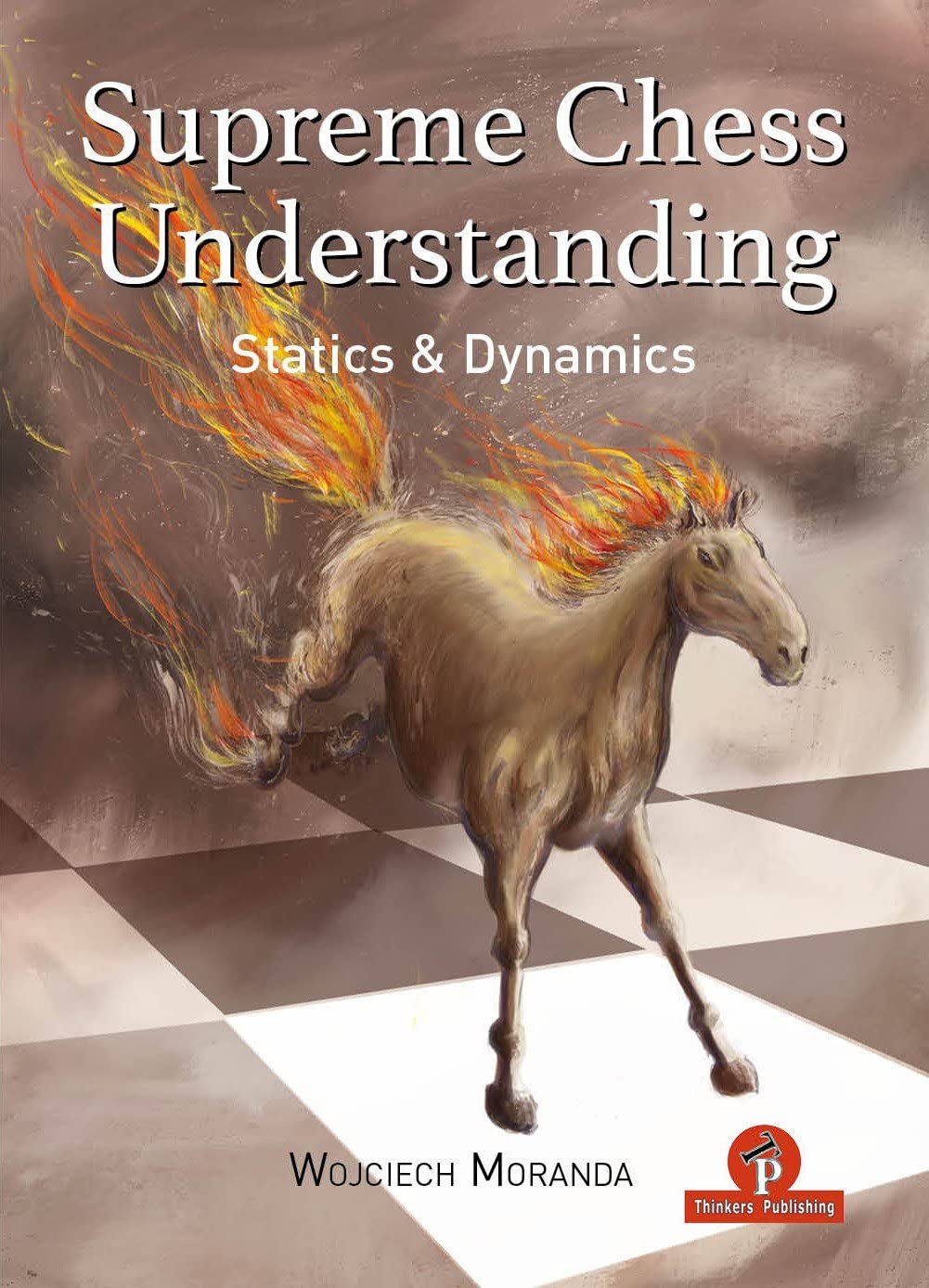From the Publisher:
“The distinction between strategy and tactics is one of the first things any chess player learns about, but have you ever heard about statics and dynamics before? Did you know that nearly every critical decision you take in a game of chess is governed by the rules of the so-called static/dynamic balance? If not, for the sake of your own chess development, you might want learn more about it from this very book!
In Supreme Chess Understanding: Statics & Dynamics, GM Moranda meticulously explains rules governing the physics of the game, focusing in particular on the interplay between static and dynamic factors. In today’s dog-eat-dog chess world it is namely not enough to know the general principles, but rather to grasp when, how and why can these be bent… or even broken. Thanks to the knowledge gained by studying this work, navigating through the maze of positional transformations is going to become a piece of cake!
The 65 (there are actually 60, not 65) carefully selected exercises are going to make your chess senses tingle with learning excitement. Apart from that, you shall also benefit from the massive amount of practical advice and psychological tips provided by the author. Finally, the book’s quiz format will make the study process not only fruitful, but above all fun!”
About the author:
“Wojciech Moranda (1988), Grandmaster since 2009, highest FIDE rating 2636 and Poland’s TOP 3 player (August 2022). His most notable recent results include, i.a. silver at the Polish Individuals (Bydgoszcz 2021) as well as team bronze at the European Teams (Čatež 2021), together with individual silver on Board 4 at the very same event. Professional chess coach training students all over the world, focused on helping talented juniors and adult improvers ascend past their previous limitations. In his work as a trainer, GM Moranda puts special emphasis on deep strategic understanding of the game, improving his students’ thought-process as well as flawless opening preparation. As an author, GM Moranda begun his adventure with writing in 2020 by publishing the best-selling Universal Chess Training with Thinkers Publishing. The book quickly became a favorite among amateurs and titled players alike, gaining high acclaim from critics too.”

A few months ago I saw some research into the optimum average score which makes a test effective. I don’t remember the exact figure offhand, but I seem to recall it was something like 70% or 75%. If they get everything right they’ve wasted their time taking the test but if they make a significant number of mistakes they haven’t fully understood the material. Interesting, but you might or might not consider it relevant to books of this nature.
Here we have three chapters, each containing 20 quiz questions, alternating between statics (positional play) and dynamics (tactical play). In each question the best continuation wasn’t found over the board. The questions in the first chapter (Bedtime solving for kids… with 10 years of experience) score 2 points each, for solving a puzzle in the second chapter (Buy this book, they said. It will be fun, they said) you’ll receive 3 points, with 5 points awarded for correct solutions in Chapter 3 (Even MC can’t touch these). Moranda helpfully includes a chart which tells you that you would expect to score 70-79% if your playing strength is 2500-2599. If your playing strength is 1800-1899, you’d expect to score 0-9%.
But he also writes that “Although I believe that this book will mostly benefit +1800 players, I do wish to encourage those rated below this threshold to try their hand.” Even though you wouldn’t be surprised if you failed to solve any of the questions? Well, perhaps. Regular readers of my reviews will know that I think authors and publishers often claim books are suitable for lower rated players than they really are, and that chess players often buy books that are too hard for them to really benefit from.
Let’s take a look inside. I’ll show you one position from each chapter.
I was looking for something to use for the Puzzle of the Week on my club website which would link up with both this book and the World Championship match, and was pleased to find this position where Ding, playing black against Artemiev in a 2021 rapidplay game, failed to come up with the optimal plan.
What you get here, as in Moranda’s previous book, which I reviewed here, is a discussion of the position and the move chosen in the game followed by a (computer generated/checked) variation demonstrating what might have happened if the correct plan had been selected.
Here, Ding should have played 13… Bxc4, followed by Na5, Nb3 and c4, with a slight advantage. Of course, as Moranda points out, you need to see the whole plan in order to justify giving up what looks like your better bishop for a knight.
Out of curiosity, I left the position on Stockfish for a bit. It soon decided that Black’s advantage was just above 0.5, but leaving it on longer saw this dwindling to 0.27, although you might consider that the practical advantage is somewhat greater as his position is perhaps easier to play.
Ding instead chose 13… Bg4, and, as he eventually won the game, no harm was done. Stockfish considers this, Bd7 and Bc8 (which Moranda doesn’t like after Bh3) all equal, but leaving the bishop to be captured on e6 would be a serious error giving White a large (1.5 or thereabouts) positional edge.
Here’s a position from the second chapter: something more challenging taken from the game Anand – Karjakin (Gashimov Memorial Rapid 2021).
Again you have to find a continuation for Black.
Karjakin was awarded one point for sacrificing his h-pawn: 22… g6, but after 23. Nxh6+ Kg7 24. Rf1 he failed to receive the remaining two points as he missed 24… Qd8, a very difficult move to find, especially in a rapid game, according to Moranda, with f5 to follow.
Again, though, we’re talking about small margins. 25. Ng4 f5 26. Qxe5 + Rxe5 27. Nxe5 gives White RNP against Q, with Stockfish assessing the position as about 0.35 in Black’s favour.
The game continued with 24… Rh8 which is assessed as about equal, but again Karjakin won anyway after Anand miscalculated.
Chapter 3 offers puzzles that ‘even MC can’t touch’: I presume he means Magnus Carlsen rather than MC Hammer.
This one’s about dynamics rather than statics. You’ll really have to calculate.
Black to play once again in Vachier-Lagrave – Duda (Zagreb Rapid 2021).
White has sacrificed a knight for an attack against the black king. There’s a threat of Rc5, with a possible mate on h7 to follow. How are you going to defend?
The correct move, which Duda failed to find, is 33… Rfe8, which earns you three points. You’ll get an extra point for meeting Rc5 with Re1 (although Qxc5 also leads to equality), and another extra point for meeting Rg5 with Re4. If you want to see the analysis you’ll have to buy the book!
(Here’s a strange thing. Moranda tells us that after Duda’s 33… Ne3, ‘White converted his advantage in a rather confident manner by … transposing cleverly into a winning rook endgame. Well, yes, but then he traded rooks into an apparently simple pawn ending that should have been drawn, but won after several blunders by both players. But that’s a story for another time and place.)
This is, in many ways, an outstanding book. Moranda is an excellent teacher with a gift for finding interesting and instructive positions, all taken from games played between 2020 and 2022. He also writes engagingly and humorously (not always totally idiomatically, but no matter) while explaining difficult concepts clearly. I really enjoyed reading it, and perhaps you will too.
The book is handsomely produced, like everything from Thinkers Publishing, looking good on both the outside and the inside. The hardback edition received by British Chess News seems to be currently unavailable according to the publisher’s website, but you can still order the paperback there.
If you’re a traditionalist who objects as a matter of principle to computer-generated analysis this probably isn’t the book for you. It’s also probably not a good choice for novice or intermediate players: the title of the first chapter suggests, not entirely seriously, that ten years’ experience may be required. Ambitious players of, say, 2200+ strength will benefit from working through the book sequentially, spending the recommended 15 minutes on each question. Below that level, from about 1800 upwards, if you find the questions too hard you’ll learn a lot from just reading through the answers. I don’t have a FIDE rating but my national rating is currently 1938. I found the puzzles in the first chapter about the right level for me, but those in the second and third chapters too hard, which sounds about right from the chart in the introduction.
If you’re a strong player with time to spare who is looking for a book which will add something extra to your play, this could be just what you’re looking for. If you just want an enjoyable read showing you some fascinating positions from recent games, this book can also be highly recommended. Congratulations to the author and publisher on an excellent publication.
You can discover more, and see some further reviews here. You’ll find some sample pages here.
Richard James, Twickenham 28th November 2024

- . Richard James
Book Details:
- Hardback: 256 pages
- Publisher: Thinkers Publishing; 1st edition (2 May 2023)
- Language: English
- ISBN-10: 9464201770
- ISBN-13: 978-9464201772
- Product Dimensions: 17.15 x 1.91 x 23.5 cm
Official web site of Thinkers Publishing



2 thoughts on “Supreme Chess Understanding – Statics & Dynamics”